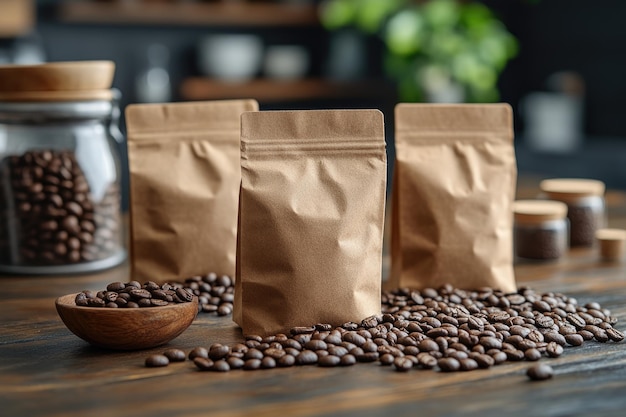Freshness is vital in the realm of forte coffee. The delicate flavors and aromas defining exceptional coffee must be preserved at every stage, from when the coffee beans are boiled to the final glass prepared. The crux of this conservation effort is the coffee packaging process, which strikes a delicate balance between providing protection from external elements and allowing for appropriate degassing. In this study on coffee packaging packs, we explore the intricate process of designing the ideal container for storing and shipping coffee beans, ensuring that every flavor delivers an unmatched tactile experience.
The Importance of Freshness in Coffee:
Before delving into the intricacies of coffee bundling, it is essential to comprehend the reasons behind the critical relevance of freshness in the coffee industry. Although coffee has a short shelf life, exposure to air, moisture, light, and intensity after it has stewed causes its quality to deteriorate rapidly. Throughout the stewing process, espresso beans undergo substantial modifications that result in intriguing flavors and aromas. In any event, when exposed to external factors, these unstable molecules are susceptible to corruption. A dull and inferior container does not provide the vibrant aromas and tastes of freshly roasted beans. Bringing the beans properly is the key to preserving the inherent properties of naturally simmering coffee. This will act as a barrier against air and other impurities while allowing the gas produced during broiling to escape.
Understanding Coffee Packaging Bags:
It’s essential to comprehend coffee bundling packs to keep your coffee beans fresh and high-quality from roastery to glass. These bags are available in various materials, including paper, plastic, thwart, and biodegradable substitutes. Each material offers unique advantages regarding light security, natural supportability, and features related to the boundary between oxygen and moisture. Important considerations for coffee packaging include natural supportability, light assurance, moisture resistance, oxygen blockage, and degassing ability. Common coffee packaging bags include level foot sacks, side gusset bags, stand-up pockets, valve sacks, and biodegradable/compostable sacks. Coffee makers can ensure optimal freshness, flavor, and aroma in every container by choosing the right packaging materials and design elements.
Factors to Consider in Coffee Packaging:
A few factors need to be considered while choosing the right coffee bean packaging to ensure optimal freshness and quality preservation:
Oxygen Barriers: Oxygen is a key component of coffee oxidation, oxidizing the oils and other components responsible for flavor and smell.Therefore, an Effective coffee cup King should provide a robust barrier against oxygen penetration to minimize presentation and preserve freshness.
Moisture Resistance: Dampness can lower the quality of coffee beans by accelerating form development and hastening flavor deterioration. Coffee bundlings should withstand moisture intrusion, particularly during humid conditions or transportation and storage.
Light Protection: Exposure to light, especially intense ultraviolet radiation, can contaminate coffee flavors and aromas. UV-resistant wrapping materials or opaque packaging are available to help protect coffee beans from damaging light exposure and preserve their tactile qualities.
Degassing Capability: The degassing capability of coffee beans occurs during the simmering process when they release carbon dioxide gas. If this gas builds up inside the bundle, it may cause the pack to bulge or explode. One-way degassing valves ensure optimal freshness without posing a risk of bundle damage by allowing carbon dioxide to be controlled while preventing oxygen from entering the sack.
Environmental Sustainability: As consumer awareness of environmental issues grows, so does the need for naturally appealing coffee bundle options that minimize waste and lessen environmental impact. Materials for recyclable, compostable, or biodegradable bundles offer more affordable options than traditional bundles without sacrificing their effective conservation characteristics.
Types of Coffee Packaging Bags:
Coffee bundling bags are available in a variety of designs and configurations, each tailored to the specific coffee packaging requirements and preferences of the coffee industry: Let’s discuss the types of packaging bags:
Flat Bottom Bags: Often referred to as quad seal sacks, these sacks stand upright on store racks thanks to a stable base that maximizes visibility and brand proximity. These sacks provide excellent protection against oxygen and moisture while providing lots of room for personalized branding and design components.
Side Gusset Bags: Unlike level bags, side gusset packs have extensible sides that provide for increased volume and capacity. With the ability to maintain freshness and rack stability, these sacks are ideal for packing larger coffee beans.
Stand-Up Pouches: Stand-up pockets are a desirable option for consumer-friendly packing because they combine the practicality of a resealable zipper with the stability of a level foot. These pockets are suitable for various coffee products, including pre-ground mixes and single-origin beans, as they come in various sizes and configurations.
Valve bags contain one-way degassing valves that let carbon dioxide escape the bundle while keeping oxygen from getting inside. These sacks work particularly well for naturally simmered coffee beans, ensuring optimal freshness and flavor preservation during storage and transit.
Biodegradable and Compostable Packs: Biodegradable and compostable coffee sacks provide an environmentally responsible alternative to traditional bundling materials in light of growing concerns about plastic contamination and natural maintainability. Due to their natural breakdown in composting environments and their composition of plant-based polymers and paper, these sacks minimize any negative environmental effects.
The Bottom Line
The best packaging coffee bags are essential in the complex world of forte coffee to maintain freshness, flavor, and aroma from the roastery to the container. Coffee bundling packs are the best defense against external factors affecting coffee quality, such as light, moisture, and oxygen. Through carefully selecting appropriate packaging materials, integrating creative design elements, and emphasizing sustainability, coffee roasters and manufacturers can ensure that every bean arrives at customers in optimal condition, ready to deliver an unmatched tactile experience. The demand for premium coffee is growing, and careful and efficient bundling arrangements are crucial to the long-term viability of the coffee industry and the enchantment of coffee lovers everywhere.

